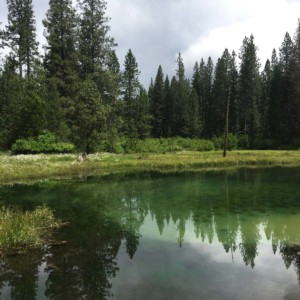Watershed conservation key to solving California’s water problems
 by Laurie Wayburn
by Laurie Wayburn
The California Water Fix/delta tunnels project is facing new challenges every day, most recently in regard to financing. Whether or not the state’s water suppliers support the plan, an essential piece is missing from the conversation: the potential of the state’s watersheds — the forests, meadows and streams that deliver water to our dams — to help solve California’s water problems.
Watershed conservation is also one of the least expensive solutions to ensure greater water quantity, quality and security. This “natural infrastructure” acts as the primary water collector and filter, purifying and storing water, then releasing it at timely intervals — all while maintaining healthy conditions in our fire-prone forests. Restoring and protecting our watersheds is something that nearly every water interest in California agrees on.
Last year, the Legislature passed and the governor signed AB 2480, which recognized source watersheds as key infrastructure elements under California’s water system, and noted their critical role in water security. This law was the first step in creating a pathway to make focused investments in restoration and protection for natural storage. A comprehensive assessment of watershed conditions is the second, and clearly demonstrates what needs to happen to maintain water security in our state.
Five source watersheds in Northern California — the Trinity, McCloud, Feather, Pit and Upper Sacramento rivers — feed the Oroville and Shasta reservoirs, which are the core of the state’s water system. These watersheds are natural storage facilities that collect, treat, store and transport drinking water to more than 28 million people, provide millions of acres of irrigation as well as 85 percent of the freshwater to the San Francisco Bay and deliver clean, renewable energy to millions of Californians.
While the state has implemented policies and systems to maintain our built water infrastructure such as dams, levees and canals and potentially, twin tunnels, there is a clear need to ensure the stability of this natural water infrastructure, which is essential for the Oroville and Shasta dams, the state’s largest.
For example, the Feather and Pit rivers, principal tributaries of the Sacramento River, are major sources of the state’s water. These watersheds are mostly meadows that, if restored, store water in the winter and then release cool water in the summer when we need it most. A newly released assessment by my organization, Pacific Forest Trust, shows that these and other primary-source watersheds are in significant decline and increasingly threatened by climate change, inconsistent land-management practices and other stressors that reduce watershed function.
Fortunately, this is reversible. It is well-documented that watershed restoration and conservation can increase water quality and quantity, as well as reduce peak flooding and retain water well into the summer. Natural storage is cost-effective, cheaper than new built infrastructure, and would allow more money to be spent on shoring up the aging infrastructure that is not holding up to the pressure of the extreme conditions we’ve experienced over the past few years.
In this era of a changing climate and extreme weather patterns, it is critical to repair and maintain our natural infrastructure if we are to build watershed resilience and mitigate the impacts of climate change. We should not count only on built infrastructure to safeguard California’s supply when we have a key solution so close at hand.
Laurie Wayburn is co-founder and president of Pacific Forest Trust. This Op Ed originally appeared on page A10 of the San Francisco Chronicle on September 29, 2017.

